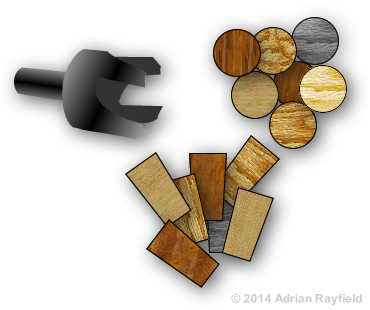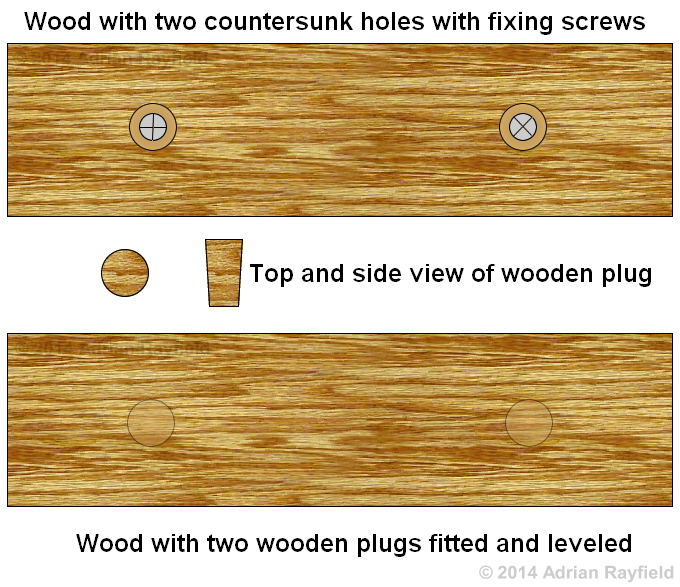Painting, decorating and home improvement tips blog
Filling holes in wood with wooden plugs
Posted by Adrian
April 22nd, 2020

Filling holes in wood with wooden plugs
When it comes to filling holes in wood, plaster etc it is typically done with a powder filler or a two part filler, as discussed in this blog post about fillers, the different types and their uses.
But what do you do if you want to fill screw holes in wood and then varnish the wood in clear varnish or leave it natural, you could use a natural coloured filler or you could use wooden plugs or pellets. This may occur, for example if you have a hardwood window sill, such as oak or mahogany and you want to use a clear varnish on it, then you don’t want to see the filler, this is where these wooden plugs come in.
What are wooden plugs
Wooden plugs are used to conceal and hide screw holes in wood without the use of a wood filler. They are made from the same wood as surrounding wood so that the grain and wood colouring match in when finished. You can make your own wooden plugs by buying a wooden plug cutter, these are available from any good hardware or timber store. They come in different sizes to match the size hole you wish to fill.
When you drill the plug you will notice the edges are slightly tapered, this is to allow for a good fit.
Using wooden plugs
Firstly you will require a piece of wood, such as an off cut of the timber you wish to fill the screw hole in. You will also need the plug cutter.
Lay the off cut on a flat surface, drill into the off cut with the plug cutter, this will produce a plug for you. Once you have the plugs you require you can fix them into place.
Take some wood glue and put a little around the plug and a little in the screw hole. Next place the plug into the hole making sure the grain of the plug runs the same way as the surrounding wood, give the top of the plug a little tap with a hammer to ensure a good tight and secure fit. Wipe any excess glue that may ooze out with a damp cloth, allow the glue to fully dry.
When the glue has fully dried you can finish the plug off, to do this you need to carefully remove the top of the plug with a sharp chisel, leave the plug just proud of the surrounding timber. The remaining plug can then be sanded down level with the surrounding area.
Once you are happy with the plug you can apply the finishing coat over the wood and the screw hole will almost be invisible.

Tags: Filler, Lumber, Powder Filler, Timber, Varish, Wood, Wooden Pellet, Wooden Plug, Wooden Plug Cutter, Woodwork
Posted in Decorating Tips, Home Improvements | No Comments »
How to paint cladding
Posted by Adrian
March 24th, 2014
How to paint cladding
Cladding is mainly used on the exterior of houses, although it can be found on the inside a house also, such as wood panelling in a bathroom. Cladding can be fixed horizontally or vertically and comes in a variety of wood types, such as pine, Cedar, and Larch.
Depending on the type of wood and the finish you require will depend on how you prepare the wood for the final protective coat, but painting, varnishing, staining etc should all be painted in the following way for best results.
Painting wooden cladding
As with any painting job, preparation is key. You should sand any previously painted surfaces and use an appropriate undercoat if required before topcoating. If the wood is new you should prepare and prime the new wood before undercoating and topcoating.
If however you are staining or varnishing a primer isn’t required, but the preparation is, for example sanding previously painted surfaces.
However you are protecting your cladding and here is a tip best to achieve the best results, you should ensure the adjoining edge is painted, or the underside for example on shiplap, once this is done fill in the board itself. Always use long strokes and don’t stop half way along a board if possible, go to a joint, stop (to move ladder for example) and then start from the joint again. If you stop half way along a board then move and start again the finish coat may of dried in and you may see a join in the final finish.
What can I paint wooden cladding in
Wooden cladding can be painted in a variety of paints and finishes, it all depends on where the cladding is and the environment it is in, for example if the cladding is on the exterior of a house you need to use an exterior paint, such as a varnish, stain, gloss or satin. Always check on the paint can to ensure the paint you wish to use suits the environment the wooden cladding is in.

Tags: Cladding, Feather Edge, Paint, Painting, Shiplap, Square Edge, Staining, Tongue and Groove, Varnish, Wood
Posted in Decorating Tips | 6 Comments »
Making life easy
Posted by Adrian
March 23rd, 2009

Wood screws – Make life easy
If you have screwed something into wood before you may of noticed two things, firstly it can be tough using a screwdriver rather than a drill, secondly you may split the wood.
There are two very simple tips you can try and they are:
- First drill a ‘pilot hole’, basically drill a smaller hole than you need allowing the screw to go in easier and the wood will not split.
- Before you screw the screw into the wood apply one of the following wd40, soap (liquid or hard), wax or oil to the thread of the screw. By doing this it makes the screw glide into the wood, it also helps the thread from not rusting so quickly on steal screws and has an added benefit that if you want to take the screw out in the future it will be far easier to do so. In fact I have taken doors off that have been hung for the best part of 100 years and the screws come out simply because rubbing wax on the threads used to be an old chippies (carpenter) trick.
Tags: Drill, Drilling, Screw, Wood
Posted in Decorating Tips | No Comments »
